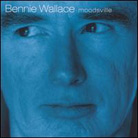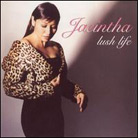![[SoundStage!]](../sslogo3.gif) The Vinyl Word The Vinyl WordBack Issue Article |
April 2002 Found on Vinyl: Bennie Wallace and Jacintha Many of you are already familiar with Groove Note. I’ve recommended their records before here at SoundStage! -- for a couple of reasons. The main one is that Groove Note offers superb music on meticulously pressed 180-gram virgin vinyl. The other is that they include with most of their offerings, at no extra charge, a second 45-rpm record (also of the 180-gram variety) that includes at least one song from the 33 1/3-rpm pressing with which you can compare the two recording speeds. The first thing I noticed when I finished unwrapping the two records under examination here, Bennie Wallace's Moodsville and Jacintha's Lush Life, was that -- surprise -- both of these vinyl releases were apparently mastered from digital recordings. Or at least that’s what appeared to be the case. The Jacintha album, unlike any of her previous releases I’ve seen from Groove Note, makes no mention of it being an all-analog recording, which could lead one to believe it’s digital. A query to Groove Note quickly unraveled that mystery. Seems that an oversight caused them to neglect to put "All Analogue" on the label. Ying Tan told me that Lush Life was recorded at 15 ips, direct to two-track analog. The Wallace record’s liner notes clearly state that for this session: "recorder - Sony Direct Stream Digital, recorded direct to two-track DSD." (Tan said they recorded this in analog too, but he and Joe Harley decided the DSD master was the equal of the analog, so they mastered it from the digital.) Moodsville and Lush Life were both produced by Mr. Harley and mastered by Bernie Grundman; so I at least feel comfort in knowing that I’ll get the best possible sound from what’s on the tapes. Still, Moodsville is something of a departure from the normal audiophile vinyl fare, being a digital-to-analog transfer, instead of the other way round.
What disappointed me, though, was the sound of Moodsville. While it’s head and shoulders above anything the majors are shucking out, it sounds flat in comparison to the best analog I’ve heard. There is no fullness to the instrumental sound. Wallace’s tenor, as an example, is clearly recorded, with plenty of detail, but that round dimensionality that is usually so evident on pure analog recordings is MIA. Another problem that I found is that both the piano and the drums are spread out over the entire soundstage. Sorry, but I just didn't find this approach all that realistic. But wait until you hear the 45-rpm EP included with the standard LP. Wow! Listening to this disc made me wonder if it came from the same master. The fullness, the dimensionality and the realness were there in spades. The only way I knew that the discs were from the same recording was the piano and drums were still spread too wide. But here the cymbals shimmer, the drumheads snap, and the piano had hammers that struck strings. And Wallace’s sax displayed the full, round, 3-D sound you hear live. I was amazed that something as simple as moving from 33 1/3 to 45 could facilitate such a change, but there you are. Moving on, just how do you like your female jazz singers? Should they be powerful? Sensual? In total control? Note perfect? Fully relaxed and at ease? When talking about Groove Note’s signature artist Jacintha, this is not a multiple-choice question. On Lush Life, she has the uncanny ability to portray all of these qualities -- separately and in combination.
Jacintha is backed on Lush Life by the Bill Cunliffe Trio (composed of Cunliffe on piano, Darek Oles on bass and Joe LaBarbera on drums) along with occasional assistance from guitarist Anthony Wilson, flugelhornist Dmitiry Matheny and, on "Boulevard of Broken Dreams", the accordion of Frankie Marocco, as well as a 12-member string section (all the string arrangements here are by Cunliffe). Now, I know what you're thinking -- this must be just another sappy jazz-with-strings recording, typical audiophile fare, nothing more than glorified Muzak, right? Wrong. There is a right way and a wrong way to record jazz with strings, and Cunliffe finds the right path on Lush Life. Never overpowering, subtle until needed, but always there, that’s about the best description I can think of for the string arrangements here. And wait until you hear the sound given this LP. It’s easily the equal of the music. This is what the entire hubbub regarding analog is all about. Laid out before you on a soundstage that stretches both wide and deep are all the instruments, each one in its own space. You hear the jazz trio set up between your speakers, with the string section spread out behind. The additional musicians, when needed, are set to either the right or left of the trio. And Jacintha’s voice floats out from the front center, a real singer in real space. Tonally, each instrument is given its own unique sonic signature; you won’t have to strain to pick out whichever line you wish to follow. My only qualms are the very slight scrim that seems to come between the music and the listener, and with the pressing quality. On my copy, there seems to be distortion present at times within the inner grooves (most noticeable on the title track). As with the Bennie Wallace above, the level of realness of this music increases along with the rotation speed. That in-the-studio-with-the-musicians sense is heightened at 45 rpms. It’s these bonus discs that set Groove Note apart from the competition. This is Jacintha’s best effort to date; one that holds out the promise of even better recordings to come. And while I might make the case that the level of musicianship was a tad higher on her previous albums, the interplay between Jacintha and Cunliffe, Oles and LaBarbera is so close, I found it hard to believe that they haven’t been playing together all their lives. Only occasionally does this kind of cohesiveness manifest itself on record. If your turntable still spins, these records deserve a spot on your platter. Groovy. ...John Crossett
|
|
![[SoundStage!]](../sslogo3.gif) All Contents All ContentsCopyright © 2002 SoundStage! All Rights Reserved |
 And let’s
begin with Bennie Wallace’s Moodsville, as this was the album I most wanted to
listen to first. I’m a big Bennie Wallace fan. His Ben Webster-meets-Eric Dolphy
approach to the tenor sax gets my juices flowing. I have listened to his last release, the
George Gershwin-inspired tribute Someone To Watch Over Me, many times, so my hopes
for this Groove Note record were quite high. I needn’t have worried. Wallace plays
with and around the melodies of the five standards (I’ll Never Smile Again,"
"April in Paris," "When a Man Loves a Women," "Love For
Sale" and "I Concentrate on You") and three jazz classics (Miles’
"Milestones", Dizzy’s "Con Alma" and Billy Strayhorn’s
"My Little Brown Book") recorded herein. His sound is very much in the Ben
Webster groove, but it’s no mere imitation. It’s Bennie Wallace pure and simple.
And let’s
begin with Bennie Wallace’s Moodsville, as this was the album I most wanted to
listen to first. I’m a big Bennie Wallace fan. His Ben Webster-meets-Eric Dolphy
approach to the tenor sax gets my juices flowing. I have listened to his last release, the
George Gershwin-inspired tribute Someone To Watch Over Me, many times, so my hopes
for this Groove Note record were quite high. I needn’t have worried. Wallace plays
with and around the melodies of the five standards (I’ll Never Smile Again,"
"April in Paris," "When a Man Loves a Women," "Love For
Sale" and "I Concentrate on You") and three jazz classics (Miles’
"Milestones", Dizzy’s "Con Alma" and Billy Strayhorn’s
"My Little Brown Book") recorded herein. His sound is very much in the Ben
Webster groove, but it’s no mere imitation. It’s Bennie Wallace pure and simple. As good as
Jacintha's first two Groove Note records were (Here’s To Ben, Autumn Leaves),
they only hinted at her vocal prowess. Here she lays much of her talent bare for all to
hear. Her almost perfect diction only serves to focus attention on the songs and their
interpretation. By returning once again to the Great American Songbook, Jacintha chooses
numbers many of us know by heart. And therein lies a potential problem. A number of these
tunes have been given definitive treatments by others, such as "Summertime" by
Ella Fitzgerald, and "September Song" by Frank Sinatra. Why does Jacintha
attempt songs already associated with more famous singers? To do them her way. For
instance, listen to Jacintha sing the Billy Strayhorn-penned title tune. She slows it
down, almost letting it bog down, yet she keeps just enough spark in the song to allow
your attention to be fixed to her next verse.
As good as
Jacintha's first two Groove Note records were (Here’s To Ben, Autumn Leaves),
they only hinted at her vocal prowess. Here she lays much of her talent bare for all to
hear. Her almost perfect diction only serves to focus attention on the songs and their
interpretation. By returning once again to the Great American Songbook, Jacintha chooses
numbers many of us know by heart. And therein lies a potential problem. A number of these
tunes have been given definitive treatments by others, such as "Summertime" by
Ella Fitzgerald, and "September Song" by Frank Sinatra. Why does Jacintha
attempt songs already associated with more famous singers? To do them her way. For
instance, listen to Jacintha sing the Billy Strayhorn-penned title tune. She slows it
down, almost letting it bog down, yet she keeps just enough spark in the song to allow
your attention to be fixed to her next verse.